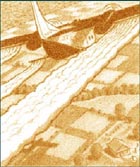
The saga of the chemical Agent Orange illustrates how the government can be immune from liability even when it is the best informed party and when its contractors are forced to pay compensation for harm.(2) Chemical companies were pressured to make these payments even though no substantive harms from Agent Orange were proven. The government simply denied liability.
During World War II, as Peter Schuck (1986, 16) discusses in his book Agent Orange on Trial, the Army formulated a number of defoliant compounds, including 2,4,5-T. The compounds were regarded as more effective, easier to apply, and safer than existing weed killers, so after the war they were made available to the private sector. The Army continued to test many herbicides.
President Kennedy approved spraying various mixtures that include 2,4,5-T, another powerful herbicide, 2,4-D, and other chemicals on the jungles of Vietnam. As U.S. involvement in Vietnam increased, so did the defoliation efforts. Agent Orange, consisting of equal parts of 2,4,5-T and 2,4-D, was introduced in 1965. Several chemical companies were compelled to provide the Army with Agent Orange under the Defense Production Act (Glasser 1986, 514). By the time its use ended in 1970, 11.2 million gallons had been sprayed over about 10 percent of South Vietnam’s land area.
Potential dangers of herbicide toxicity in general and of Agent Orange in particular had been known by Army officials for some time. Monsanto, one of the largest producers of Agent Orange, informed army officials that 2,4,5-T was a toxic substance as early as 1952. A 1963 Army review of toxicity studies of 2,4,5-T concluded that there was an increased risk of chloracne (a severe but often treatable skin condition) and respiratory irritations, and that the risk was heightened when the chemical was applied in high concentrations by inexperienced personnel.
The Army knew as much, and probably more, about the potential dangers of the herbicides as any company that manufactured them. The Joint Chiefs of Staff were also informed of potential health dangers of herbicides by the President’s Science Advisory Committee in 1963. President Johnson’s Science Advisory Committee apparently discussed the potential toxicity of 2,4,5-T in meetings between April and June of 1965. The National Cancer Institute contracted with Bionetic Research Laboratories in 1965 to study the potential toxicity of a number of herbicides and pesticides, including both 2,4-D and 2,4,5- T. A preliminary report indicating potential dangers was not made public until 1969 when it was leaked to Ralph Nader.
Before this, the Army had denied (perhaps correctly) that any serious danger existed, but on April 15, 1970, the Army stopped using Agent Orange. Subsequently, veterans, claiming that they had contracted diseases from Agent Orange, initiated litigation to obtain compensation.
Despite evidence of substantial knowledge by government officials of potential health hazards of Agent Orange, the government denied virtually all liability. The government’s lead attorney on the case stated: “The United States declines to attend or participate in settlement negotiations or court settlement of this case because any settlement that calls for contribution by the United States is not warranted. This is the United States’ firm position, and we anticipate no change whatever in any aspect of it” (Schuck 1986, 148).
Although there are substantial scientific questions regarding causality with respect to many of Agent Orange’s alleged health effects (Franklin 1994, 3–4), the judge in the case manipulated the producers of Agent Orange into a $180 million settlement. This was in addition to their legal fees, estimated to be in the $100 million range (Schuck 1986, 5). If government officials were correct in denying any liability, then the producers should also have been free of liability. The defendants attempted to recover litigation expenses and settlement costs from the federal government. They were not successful, as the Supreme Court affirmed lower court rulings against them in 1996.(3)
To the degree that Agent Orange causes harm, the case appears to be one of gross negligence on the part of government officials. Immunity for such officials can apply even when potential harms are intentionally inflicted.(4)
There are many other examples of government actions that exposed people to toxic materials without legal liability. Consider just a few examples.
- The Department of Defense (DOD) apparently knew of potential risks associated with experimental drugs and vaccines before the Gulf War but administered them to troops anyway, with no warning and no monitoring (Ritter 1994).
- The DOD has identified 10,439 suspected hazardous waste sites on active military installations that require cleanup or additional investigation. Over 100 of these facilities are on the Environmental Protection Agency’s “Superfund” National Priorities List of the worst contaminated sites in America (Calhoun 1994).
- U.S. Department of Energy nuclear weapons laboratory, production, and test facilities have “an estimated 4,500 contamination sites covering tens of thousands of acres of land,” and nine of these facilities are on the Superfund priorities list (Center for Defense Information 1994, 1). These nuclear weapons facilities have produced more than 99 percent of all the high-level radioactive waste in America. Several facilities are so contaminated that they probably will simply be sealed off from public access as “national sacrifice zones.”
- While industry is recognized as the major producer of chlorofluorocarbons (CFCs such as Freon), which allegedly deplete the stratospheric ozone layer, estimates made in 1989 suggest that the armed services and their contracted weapons producers were responsible for about 37 percent of the nation’s Freon emissions (Siegel 1990, 1).
- Millions of tons of asbestos were used to insulate ships built in naval shipyards. The way it was applied exposed many thousands of workers to dangerous levels of asbestos, unlike the relatively safe way that asbestos was used in building construction. As Chen (1984, 26) notes, “Even though the vast majority of asbestos victims worked in government shipyards, the United States government continues to reject any suggestion that it bears a moral, if not a legal, obligation to the victims.”
The list goes on and on. It is a sad commentary on government “responsibility. ”
Notes
1. Federal Tort Claim Act, 1946; Feres v. U.S., 340 U.S. 135 (1950).
2. Much of this discussion is drawn from Schuck (1986).
3. Hercules Inc. et al. v. United States, Yock, J., 25 Cl. Ct. 616; 26 Cl. Ct. 17; aff’d, 24 F. 3d 188; aff’d, 116 S.Ct. 981 (1996).
4. A large number of radiation experiments on human subjects were conducted between 1945 and 1970, for instance, some of which exposed large civilian populations (Oakland Tribune 1994).
References
Calhoun, Martin. 1994. The Military and the Environment. Defense Monitor 23(9): 1–7. Center for Defense Information. 1994. Nuclear Threat at Home: The Cold War’s Lethal Leftovers. Defense Monitor 23(2): 1–8. Chen, Edwin. 1984. Asbestos Litigation is a Growth Industry. Atlantic July, 24–32. Franklin, Jon. 1994. Poisons of the Mind. Activities 14: 1–6. Glasser, Jonathan. 1986. The Government Contractor Defense: Is Sovereign Immunity a Necessary Perquisite? Brooklyn Law Review 52: 495–531. Oakland Tribune. 1994. ’65 Nuke Fallout Hit L.A. August 26. Ritter, John. 1994. Report: Military Knew Risks of Gulf War Drugs. USA Today, December 8. Schuck, Peter H. 1986. Agent Orange on Trial: Mass Toxic Disasters in the Courts. Cambridge, MA: Belknap Press. Siegel, Lenny. 1990. No Free Launch: The Toxic Impact of America’s Space Programs. Sabattus, ME: Military Toxics Project.
Bruce L. Benson is Devoe Moore Distinguished Research Professor of Economics at Florida State University. This article is excerpted from Cutting Green Tape, edited by PERC Senior Associates Richard L. Stroup and Roger E. Meiners (Transaction Publishers).


